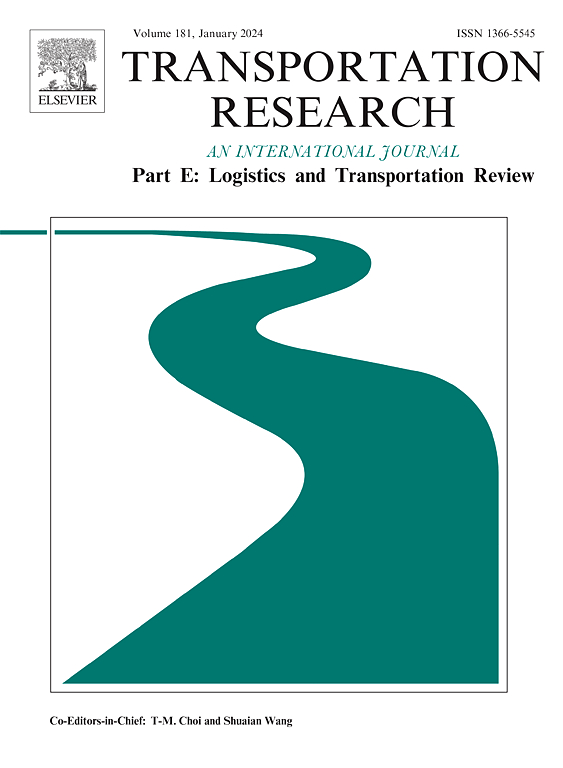Supply chain resilience modeling based on dynamic hypergraph and quantum reinforcement learning for low-altitude-ground networks
IF 8.8
1区 工程技术
Q1 ECONOMICS
Transportation Research Part E-Logistics and Transportation Review
Pub Date : 2025-10-09
DOI:10.1016/j.tre.2025.104458
引用次数: 0
Abstract
This study proposes an innovative resilience optimization framework integrating dynamic hypergraph theory and quantum reinforcement learning to address the unique structural characteristics and vulnerabilities of low-altitude economic supply chain networks. By incorporating multi-source supply chain data, we construct a dynamic hypergraph model based on Spearman rank correlation, revealing the hub-and-spoke topological features of low-altitude supply networks. Utilizing quantum state encoding and entanglement gate optimization techniques, we develop a quantum reinforcement learning algorithm with stable convergence properties for real-time optimization in high-dimensional decision spaces. Furthermore, we establish a quantum-inspired anomaly detection system that effectively identifies systemic risks through spectral analysis and multivariate statistical process control. Model validation results confirm the framework’s capability to accurately capture seasonal fluctuation patterns in low-altitude supply chains and provide early warnings for critical infrastructure nodes. The proposed approach significantly reduces seasonal disruption durations while avoiding off-peak resource redundancy through strategic inventory buffering of key hub nodes and dynamic supplier adjustments. The research contributes three key aspects to low-altitude supply chain management: (1) topology-aware planning methods based on hypergraph centrality metrics, (2) quantum adaptive optimization strategies incorporating temporal patterns, and (3) proactive risk management systems driven by quantum spectral analysis. This work not only provides novel management tools for emerging low-altitude economic systems but also opens new research pathways for resilience optimization in complex supply chain networks.
基于动态超图和量子强化学习的低空地面网络供应链弹性建模
本文提出了一种结合动态超图理论和量子强化学习的创新弹性优化框架,以解决低空经济供应链网络独特的结构特征和脆弱性。通过整合多源供应链数据,构建了基于Spearman秩相关的动态超图模型,揭示了低空供应网络的轮辐拓扑特征。利用量子态编码和纠缠门优化技术,我们开发了一种具有稳定收敛特性的量子强化学习算法,用于高维决策空间的实时优化。此外,我们建立了一个量子启发的异常检测系统,通过光谱分析和多元统计过程控制有效地识别系统风险。模型验证结果证实,该框架能够准确捕捉低空供应链中的季节性波动模式,并为关键基础设施节点提供早期预警。该方法通过关键枢纽节点的战略性库存缓冲和动态供应商调整,显著减少了季节性中断持续时间,同时避免了非高峰资源冗余。该研究为低空供应链管理提供了三个关键方面的帮助:(1)基于超图中心性度量的拓扑感知规划方法;(2)结合时间模式的量子自适应优化策略;(3)基于量子光谱分析的前瞻性风险管理系统。这项工作不仅为新兴低空经济系统提供了新的管理工具,而且为复杂供应链网络的弹性优化开辟了新的研究途径。
本文章由计算机程序翻译,如有差异,请以英文原文为准。
求助全文
约1分钟内获得全文
求助全文
来源期刊
CiteScore
16.20
自引率
16.00%
发文量
285
审稿时长
62 days
期刊介绍:
Transportation Research Part E: Logistics and Transportation Review is a reputable journal that publishes high-quality articles covering a wide range of topics in the field of logistics and transportation research. The journal welcomes submissions on various subjects, including transport economics, transport infrastructure and investment appraisal, evaluation of public policies related to transportation, empirical and analytical studies of logistics management practices and performance, logistics and operations models, and logistics and supply chain management.
Part E aims to provide informative and well-researched articles that contribute to the understanding and advancement of the field. The content of the journal is complementary to other prestigious journals in transportation research, such as Transportation Research Part A: Policy and Practice, Part B: Methodological, Part C: Emerging Technologies, Part D: Transport and Environment, and Part F: Traffic Psychology and Behaviour. Together, these journals form a comprehensive and cohesive reference for current research in transportation science.

 求助内容:
求助内容: 应助结果提醒方式:
应助结果提醒方式:


